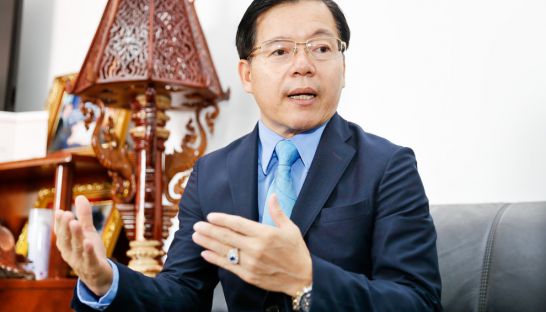Credit hunger still voracious
Credit hunger still voracious
In its 10th year, Cambodia’s growing microfinance sector has seen stellar credit and deposit growth. But concerns remain over this speed of credit growth in the sector, as well as the rise in unlicensed lenders operating in rural areas.

The Post’s Sokhorng Cheng sat down with Hout Ieng Tong, president and CEO of Hattha Kaksekar and newly-elected president of the Cambodia Microfinance Association (CMA), to discuss potential growth areas and the association’s role in developing the sector.
As the new president of the CMA, what will be your priorities for the organisation?
I am really honoured to have been selected as president of CMA again. I think the microfinance sector is currently flourishing and developing well over the last 10 years, when the sector started off. This is because of good governance and political stability, as well as sound policies adopted by the microfinance sector. We are eager to encourage all microfinance institutions (MFI) to become a member of the CMA, in order to increase transparency and maintain fair competition in the market. We must have the same goals and seek solutions to problems facing MFIs together in order to serve and better develop the sector in Cambodia.
Despite incredible growth, what are the challenges facing the microfinance sector?
I see that a lot of microfinance operators do not have enough capital to give out as loans. So they have to borrow capital from foreign banks, which comes at a high interest to the borrower. The other challenge is the limited amount of qualified human resources in the sector, which leads to operators poaching staff from other MFIs and this can hamper their operations. And the last challenge is the increase in MFIs, which increases competition in the market. But this can also be a good thing, because as MFIs increase borrowers can get better interest rates for their loans and good service. So our strategy is to address these challenges as we want to encourage all microfinance operators to join the CMA. This will help build capacity by increasing access to training for customer services and credit evaluation, and ensure fair competition, which will benefit all members.
MFIs saw a surge last year increasing both deposits and loans by 40 per cent. Do you think this will continue or will the sector start to cool off?
I think both deposits and loans will continue to increase this year and would be around 45 per cent to 50 per cent. But when it comes to the number of borrowers there will probably be only a little growth.
Do you think moving forward growth will come from deposits or loans? How much growth is still out there in the market?
In the sector right now, loans are more popular than deposits because citizens need capital to expand their business. So the demand for loans will be bigger than deposits collected. This is because a lot of clients view an MFI as a place for providing loans rather than to deposit their money. Whereas commercial banks are looked upon as the place to keep your deposits. So deposit collection will always be less than loans given out, which is why MFIs have to look for funding from foreign banks.
The daily banking facilities are limited with the deposit-collecting MFIs, which is why customers prefer using a commercial bank for those activities, such as making payments abroad or money transfers.
What is the CMA doing to stop unlicensed firms who are hurting customers by taking loans at very high interest rates?
The CMA cannot itself take any action against these kinds of MFIs, That is the responsibility of the National Bank of Cambodia to crack down on illegal and unlicensed MFIs. What the CMA can do is to observe operators in the market, collect information on them and inform the central bank of any illegal operators.
The MEF last month said it was worried about the rapid growth of credit in the MFI sector. Do you think that MFIs are giving out too many loans just to achieve growth?
I do agree that the MEF is concerned with the rapid growth of credit, but I don’t think it is specific to the MFI sector but the concern extends to the whole financial sector. When the amount of credit is higher than the collection of deposits, it does increase risk in the market. But currently, it is not a concern for us because despite a high demand for credit, the amount of credit owed by Cambodian citizens is still small compared to the other countries. So the space for the amount of credit to increase.













